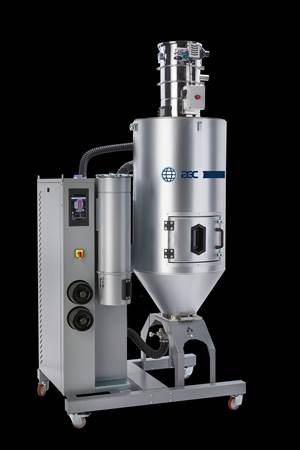Molder Slashes Energy Cost With Move to Desiccant Drying
Yes there are still molders drying with tray ovens. But this processor replaced the last few it had and has reaped some impressive energy-savings benefits.
A precision injection molder has rid itself of the last vestiges of outdated technology, and received significant energy savings and part-quality improvements as a result.
That’s the short story behind a recent move by Sinicon Plastics (sinicon.com), a 44-year-old custom molder that operates from a 35,000 ft² plant in Dalton, Mass., to replace its tray-style drying ovens with up-to-date, energy-efficient drying systems from Dri-Air Industries, East Windsor, Conn. Sinicon was no stranger to modern drying technology, already having a handful of Dri-Air systems in operation.
Sinicon specializes in molding engineering resins and liquid silicone rubber (LSR) for medical, military, aerospace, and industrial applications. It offers horizontal/vertical insert molding, micromolding, cleanroom molding, overmolding, secondary machining, assembly, and in-house tool building. Production volumes range from prototypes to hundreds of thousands of parts.
While some might be surprised that a sophisticated molder would hang on to tray ovens in this day and age, drying experts confirm that they still have a place in drying very small batches of material, or when working with resins that tend to clump in the hopper.
Sinicon moved to the Dalton facility from nearby Pittsfield two years ago. That set the wheels in motion for it to investigate energy-saving initiatives. The firm focused on two key areas—resin drying and factory lighting—and has taken significant measures regarding both that have kept the electric costs in the new building equal to those in the previous smaller space.
“After we purchased new energy-efficient dryers from Dri-Air and retrofitted more efficient lighting, we haven’t seen any increase in our electric bill—although we have doubled in size in our new space,” says David Allen, president of Sinicon.
“Resin drying is a major component of our energy costs,” adds Allen. “We had a few Dri-Air dryers already and had been very happy with their performance. But when Dri-Air came to our plant and performed an energy audit for us—showing the benefits of fully converting to their drying systems—it was an easy decision to switch over our drying completely. The Dri-Air systems have saved us significantly with our energy costs, have improved the quality of resin drying, and reduced the labor associated with our drying function.”
Sinicon previously had three 10-tray units equipped with timers. The resin drying process used heated ambient air to “bake” the moisture out of the material. This process took a considerable amount of time as the ambient air was not dried before being circulated through the convection ovens.
“The new dryers supplied by Dri-Air use half the amount of energy consumed by the tray ovens,” Allen says. “With the ovens, we were forced to dry different resins all at the same temperature. We would leave the resin in them overnight to dry, so that by morning we had resin suitable for production.
“We found with the Dri-Air desiccant-bed dryers that we cut countless hours of drying out of our process. They dry the resin faster and better, and we can customize the drying parameters to accommodate the resin being dried. The portable dryers also include conveying equipment that moves the resin right into the small receivers on the press, eliminating the need for us to move it manually. The timers allow us to start drying the resin late at night so that each morning we are ready for production.”
Sinicon Plastics also received a check for $30,000 from the Western Massachusetts Electric Co., which subsidized half the investment in the new dryers.
Related Content
Why (and What) You Need to Dry
Other than polyolefins, almost every other polymer exhibits some level of polarity and therefore can absorb a certain amount of moisture from the atmosphere. Here’s a look at some of these materials, and what needs to be done to dry them.
Read MoreHow to Effectively Reduce Costs with Smart Auxiliaries Technology
As drying, blending and conveying technologies grow more sophisticated, they offer processors great opportunities to reduce cost through better energy efficiency, smaller equipment footprints, reduced scrap and quicker changeovers. Increased throughput and better utilization of primary processing equipment and manpower are the results.
Read MoreWheel Dryers for Beside-the-Press, Small Central Applications
Precision control on the dryer series reportedly prevents the thermal, chemical and physical material degradation that can result from long drying times at high temperatures and high air flow.
Read MoreAI Manages Resin Drying Airflows and Throughputs for Energy Savings
NPE2024: Optional feature automates the process of maintaining process-ready resins at perfect temperatures and varied throughputs, while preventing overdrying and realizing significant energy savings.
Read MoreRead Next
Beyond Prototypes: 8 Ways the Plastics Industry Is Using 3D Printing
Plastics processors are finding applications for 3D printing around the plant and across the supply chain. Here are 8 examples to look for at NPE 2024.
Read MoreRecycling Partners Collaborate to Eliminate Production Scrap Waste at NPE2024
A collaboration between show organizer PLASTICS, recycler CPR and size reduction experts WEIMA and Conair will seek to recover and recycle 100% of the parts produced at the show.
Read More


























